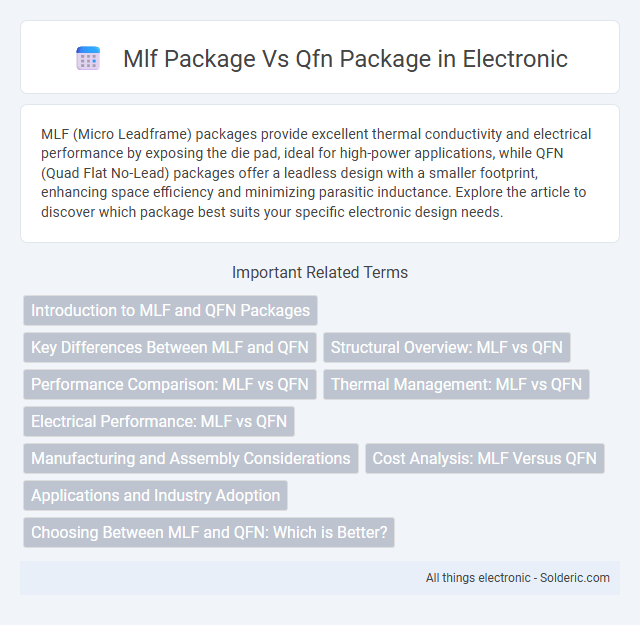MLF (Micro Leadframe) packages provide excellent thermal conductivity and electrical performance by exposing the die pad, ideal for high-power applications, while QFN (Quad Flat No-Lead) packages offer a leadless design with a smaller footprint, enhancing space efficiency and minimizing parasitic inductance. Explore the article to discover which package best suits your specific electronic design needs.
Comparison Table
| Feature | MLF Package (Micro Leadframe) | QFN Package (Quad Flat No-Lead) |
|---|---|---|
| Lead Type | Exposed leads on bottom, minimal leadframe | Exposed copper pads on bottom, no external leads |
| Size | Smaller footprint, thin profile | Compact, low-profile design |
| Thermal Performance | Moderate heat dissipation via leadframe | Excellent thermal conductivity via exposed pad |
| Electrical Performance | Good signal integrity with leadframe | Improved signal performance with reduced inductance |
| Assembly | Requires precise soldering of leads | Surface mount with solder paste on pads, easier reflow |
| Cost | Generally lower cost due to simpler structure | Typically higher cost but better reliability |
| Applications | Used in compact consumer electronics | Widely used in RF, power electronics, and high-performance chips |
Introduction to MLF and QFN Packages
MLF (Micro Leadframe) and QFN (Quad Flat No-Lead) packages are widely used in semiconductor device packaging for their compact size and excellent electrical performance. MLF packages feature a leadframe-based design with exposed pads on the bottom for optimal heat dissipation, commonly utilized in high-frequency and power applications. QFN packages provide a leadless, square or rectangular footprint with exposed thermal pads, offering low inductance and enhanced thermal management in mobile and consumer electronics.
Key Differences Between MLF and QFN
MLF (Micro LeadFrame) packages feature a smaller footprint and thinner profile compared to QFN (Quad Flat No-Lead) packages, making MLF ideal for space-constrained applications. QFN packages include exposed thermal pads that enhance heat dissipation, improving performance in high-power devices, whereas MLF packages may lack this thermal pad, offering limited heat conduction. Your choice between MLF and QFN impacts thermal management, board space utilization, and assembly processes depending on your device requirements.
Structural Overview: MLF vs QFN
The MLF (Micro Lead Frame) package features a lead frame with no exposed leads extending from the package edges, providing a compact, flat surface ideal for high-density PCB layouts, whereas the QFN (Quad Flat No-lead) package uses leads along all four sides with a thermal pad exposed on the bottom for enhanced heat dissipation. MLF packages typically offer reduced parasitic inductance due to their shorter leads and smaller footprint, improving electrical performance in RF applications, while QFN packages balance thermal management with ease of assembly through their exposed pad design. The structural difference lies in the lead configuration and thermal pad exposure, impacting thermal resistance, electrical performance, and PCB mounting techniques.
Performance Comparison: MLF vs QFN
MLF (Micro Lead Frame) packages offer superior thermal performance compared to QFN (Quad Flat No-lead) packages due to their exposed pad design, which enhances heat dissipation and reduces junction temperature. QFN packages provide excellent electrical performance with lower inductance and resistance, benefiting high-frequency applications. Your choice depends on whether thermal management or electrical performance is the primary priority in your device design.
Thermal Management: MLF vs QFN
The MLF (Micro LeadFrame) package offers superior thermal management due to its exposed die pad directly soldered to the PCB, facilitating efficient heat dissipation. QFN (Quad Flat No-lead) packages also provide good thermal performance but typically have a larger footprint, which can affect heat spreading on smaller boards. MLF's smaller size and exposed pad design make it more effective for high-power applications requiring enhanced thermal conductivity.
Electrical Performance: MLF vs QFN
The MLF (Micro Leadframe) package offers lower inductance and capacitance compared to the QFN (Quad Flat No-Lead) package, resulting in improved high-frequency electrical performance. MLF packages provide better thermal conductivity and lower electrical resistance, enhancing signal integrity and reducing noise. QFN packages, while similar in leadframe design, often exhibit slightly higher parasitic effects, making MLF preferable for high-speed and precision applications.
Manufacturing and Assembly Considerations
MLF (Micro Lead Frame) packages offer superior thermal performance and easier automated assembly due to their exposed thermal pad and lead frame design, enhancing solder joint reliability during manufacturing. QFN (Quad Flat No-Lead) packages provide a compact footprint with bottom-side terminals, requiring precise solder paste application and alignment to avoid defects such as tombstoning or insufficient solder joints. Your choice between MLF and QFN impacts assembly yield, reflow profile optimization, and thermal management strategies on the PCB.
Cost Analysis: MLF Versus QFN
MLF (Micro LeadFrame) packages typically offer lower manufacturing costs compared to QFN (Quad Flat No-lead) packages due to their smaller footprint and reduced material usage. Your choice impacts production budget as MLF's simpler design requires less complex assembly processes, resulting in cost savings for high-volume orders. However, QFN packages often provide better thermal performance and mechanical reliability, which might justify a higher initial expense depending on application requirements.
Applications and Industry Adoption
MLF packages are widely used in high-frequency and microwave applications due to their superior thermal performance and low signal loss, making them ideal for telecommunications and automotive radar systems. QFN packages offer cost-effective solutions with excellent electrical performance, commonly adopted in consumer electronics, IoT devices, and mobile phones. Your choice between MLF and QFN depends on the specific industry requirements for thermal management and electrical efficiency.
Choosing Between MLF and QFN: Which is Better?
Choosing between MLF (Micro Leadframe) and QFN (Quad Flat No-Lead) packages depends on factors like thermal performance, size constraints, and circuit complexity. QFN packages generally offer superior heat dissipation due to their exposed pad design, making them ideal for high-power applications, while MLF packages provide a more compact footprint suitable for dense PCB layouts. Evaluating specific application requirements such as electrical performance, PCB space, and manufacturing considerations helps determine which package is better suited for a given electronic component.
mlf package vs qfn package Infographic

 solderic.com
solderic.com